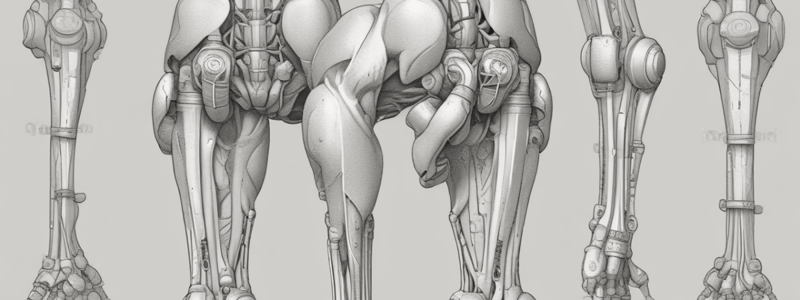Podcast
Questions and Answers
What type of movement does a hinge joint allow?
What type of movement does a hinge joint allow?
- Rotational movement only
- Movement in all directions
- No movement at all
- Movement in only one direction (correct)
A pivot joint allows only rotational movements.
A pivot joint allows only rotational movements.
False (B)
What is the function of ligaments in hinge joints?
What is the function of ligaments in hinge joints?
To prevent side to side movement
The ball and socket joint is the most mobile of the ____________________ joints.
The ball and socket joint is the most mobile of the ____________________ joints.
Which type of joint is found between the small bones of the hand?
Which type of joint is found between the small bones of the hand?
The condyloid joint is a type of hinge joint that allows some sideways movement.
The condyloid joint is a type of hinge joint that allows some sideways movement.
Match the following joints with their examples:
Match the following joints with their examples:
What is the characteristic of a saddle joint?
What is the characteristic of a saddle joint?
Study Notes
Types of Joints
- Hinge Joint
- Formed by a curving out surface of one bone fitting into a curving in surface of another bone
- Allows movement in only one direction (back and forth, i.e., bending and straightening)
- Examples: knee, elbow, and ankle
- Ball and Socket Joint
- Formed by a rounded head of one bone fitting into a cup-shaped socket of the other bone
- Allows a wide range of movement (side to side, back and forth, rotating)
- Examples: shoulder (humerus + scapular) and hip (pelvis + femur)
- Allows movement through three planes (flexion, extension; abduction, adduction; rotation)
- Pivot Joint
- Formed by a pivot-like projection of one bone rotating inside a ring-shaped structure on the other bone
- Allows rotational movements and some bending
- Examples: joint at the top of the vertebral column (C1 and C2 vertebral joint) and radioulnar joint
- Gliding Joint (Plane)
- Formed by two bones with flat surfaces sliding on each other
- Limited movement due to ligaments
- Found between small bones of the hand (carpals)
- Saddle Joint
- Formed by convex and concave surfaces placed against each other
- Allows movement in two directions (side to side and back and forth)
- Example: joint between the hand and the base of the thumb (carpal + metacarpal joint)
- Condyloid Joint (Ellipsoid)
- Formed by a dome-shaped surface of one bone fitting into the hollow formed by one or more other bones
- Allows both side to side and back and forth movements
- Example: joint between the radius, ulna, and carpal bones in the wrist
- Allows flexion, extension; adduction, abduction; and circumduction
Studying That Suits You
Use AI to generate personalized quizzes and flashcards to suit your learning preferences.
Description
This quiz covers the two main types of joints: Hinge joints and Ball and socket joints. Learn about their characteristics and examples.




